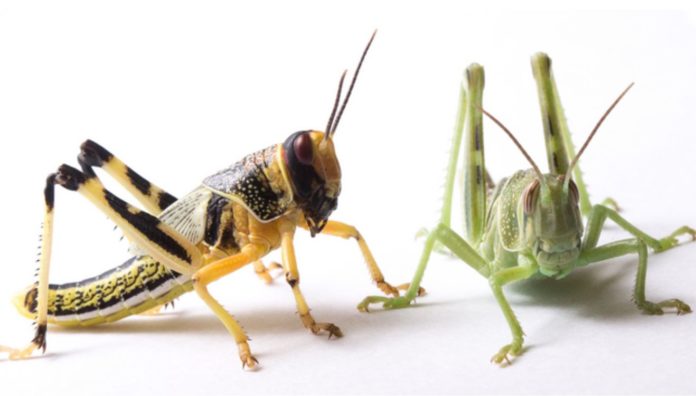Scientists from the U.S. Department of Agriculture’s Agricultural Research Service have created the first high-quality genome of the desert locust, the most damaging migratory insect in the world and those voracious feeders of plague and devastation infamy.
The desert locust (Schistocerca gregaria) has a massive genome, approximately three times the size of the human genome, at little under 9 billion base pairs.
“We were concerned that, faced with this huge and very likely complex desert locust genome, it was going to be an extremely long and difficult job,” said entomologist Scott M. Geib, one of the team leaders, “However, we were able to go from sample collection to a final assembled genome in under 5 months.” One of the largest insect genomes to be fully sequenced came from a single locust, the desert locust.
Baldwyn Torto, a chemical ecologist with the International Centre of Insect Physiology and Ecology (ICIPE) in Nairobi, Kenya, provided that one locust. He and his colleagues located locust swarms and collected samples all throughout Kenya until they had two parents that they could crossbreed to create an offspring with a recognized lineage.
When compared to the model fruit fly Drosophila melanogaster, the first insect genome ever built, the desert locust’s chromosomal size is astounding. The genome of the fruit fly is larger than many of the individual chromosomes of the desert locust.
“With the desert locust, we were dealing with a much larger genome in many fewer pieces—about 8.8 Gb in just 12 chromosomes. Next to the fruit fly, it’s like an 18-wheeler next to a compact car,” Geib added. “It was like sequencing a typical insect genome many, many times over. But with today’s advances in DNA sequencing technologies, we are now able to generate extremely accurate genomes of insects that previously would have been unapproachable.”
Through the National Center for Biotechnology Information, the ARS has made the genome accessible to the community of researchers operating all over the world.
Desert locust plagues are cyclical and have been recorded as far back as 3200 B.C. in ancient Egypt, under the reign of the Pharaohs. Swarms of desert locusts have been observed in recent decades in the years 1967–1969, 1986–1989, and most recently in 2020–2022. They wreck havoc throughout Southwest Asia, the Middle East, and East Africa, endangering the food security of many nations.
Their harm can be very severe. According to the Food and Agriculture Organization of the United Nations, a small swarm can consume as much food in a day as would feed 35,000 people; a swarm of historic proportions covering the area of New York City consumes as much in a day as the population of New York, Pennsylvania, and New Jersey combined.
The main method used to control desert locusts today is to find swarms and spray them with broad-spectrum pesticides. This genetic research may ultimately reduce the need for such insecticides.
Finding targeted controls requires a high-quality genome, according to Geib. It will also provide us with important details on cousins of the desert locust, such as the Mormon cricket, another swarming species that could threaten the food security of the United States and are significant pests in the Americas.
The Ag100Pest Initiative, an ARS program, aims to create high-quality genomes for the top 100 arthropod pests in agriculture as a starting point for scientific and practical research. This work is a component of that initiative.
Image Credit: Getty
You were reading: First High-quality Genome of The Voracious Desert Locust Completed
